#new zealand mammal
Explore tagged Tumblr posts
Text
The Great ACT-NSW-NZ Trip, 2023-2024 - Otago Peninsula Eco Restoration Alliance
While in Dunedin we spent the better part of a day out towards the tip of the Otago Peninsula, via a tortously convoluted road that followed the shoreline where the heart had been chewed out of the Dunedin Volcano. There were a couple of things out that end of the Peninsula that @purrdence and I wanted to see - the OPERA eco-reserve where I was hoping to see Yellow-eyed Penguins, and the Little Penguin rookery and Royal Albatross rookery that I'll cover seperately.
I wasn't in the OPERA Reserve for long - they can only handle so many visitors at a time so they had to keep everybody moving - but I still saw a good range of stuff. Including species familiar to me from back in Perth :/













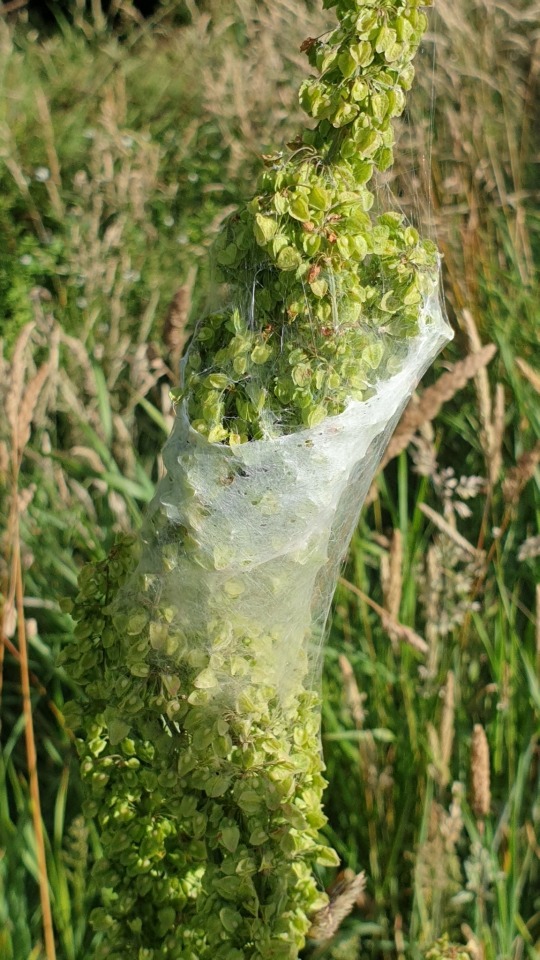



#new zealand moth#fur seal#sealion#new zealand mammal#Otariidae#Phocarctos#sea lions#sea lion#marine mammal#Eudyptula#little penguin#fairy penguin#penguin#new zealand bird#seabird#Spheniscidae#new zealand insect#Orthoclydon#Flax Window-Maker#geometridae#Arctocephalus#Pales#new zealand fly#Eudonia#Crambidae#Calliphora#calliphoridae#introduced species#australian fly#Ichneutica
2 notes
·
View notes
Text


#australian wildlife#invasive in new zealand#brushtail possum#common brushtail possum#mammalia#mammal#mammals#marsupial#marsupialia#diprotodontia#phalangeridae#possum#animal polls#poll blog#my polls#animals#polls#tumblr polls
68 notes
·
View notes
Text
🐬 Daily Cetacean Fact: 🐬
Hector's Dolphin: Hector's dolphin is the only cetacean endemic to New Zealand. Similar to the Hourglass Dolphin, Hector's dolphins use high-frequency echolocation clicks. However, the Hector's dolphin produces lower source-level clicks than the hourglass due to their crowded environment. This means they can only spot prey at half the distance. The species has a very simple repertoire with few types of clicks, as well as little audible signals in addition to these.
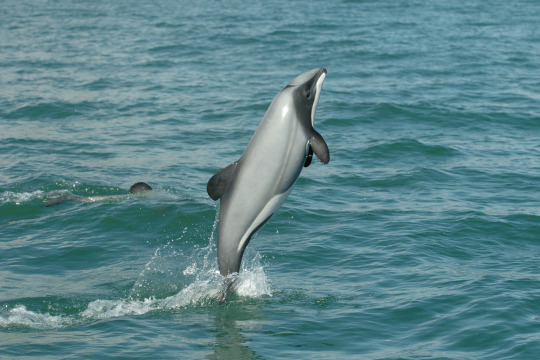

#hectors dolphin#dolphin#cetacean#daily cetacean#daily dolphin#daily cetacean fact#daily dolphin fact#dolphin fact#cetacean fact#facts about cetaceans#facts about dolphins#respect the locals#shark blog#ocean animal#ocean life#ocean#marine animals#marine biology#marine life#marine mammal#marine#new zealand
56 notes
·
View notes
Text
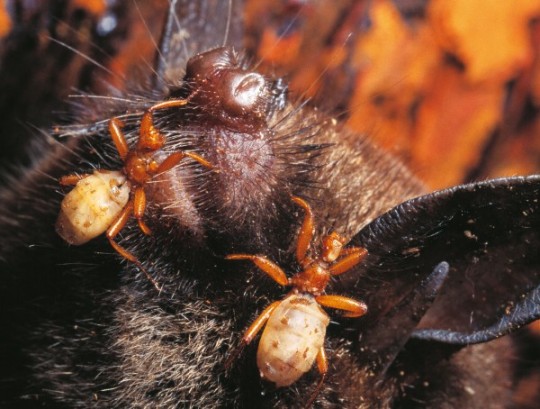
New Zealand Batfly (Mystacinobia zelandica)
Habitat & Distribution
Endemic to the island of Aotearoa (New Zealand)
Found in the colonies of New Zealand short-tailed bats, which reside primarily in caves, forests, and agricultural areas
Physical Description
Length: 4–9 mm (0.15-0.35 in)
Although they are true flies, the New Zealand batfly is wingless; they also lack eyes, and instead use specialized hairs to sense its surroundings
Both sexes are orange, with darker heads and lighter abdomens
Behaviour
New Zealand batflies are reliant on the guano produced by New Zealand short-tailed bats; they both feed on the guano and lay their eggs in it
They live in colonies, with males closely guarding clutches of eggs
To disperse, individuals attach themselves to the fur of the New Zealand short-tailed bat and hitch a ride to new colonies
Key Advantages
To avoid predation, males produce a high-frequency buzz that can disorient or deter bats
Due to their small size, they may difficult to find
See where they stand in the May Mammal Madness Tournament here!
Photo by Rod Morris
36 notes
·
View notes
Text
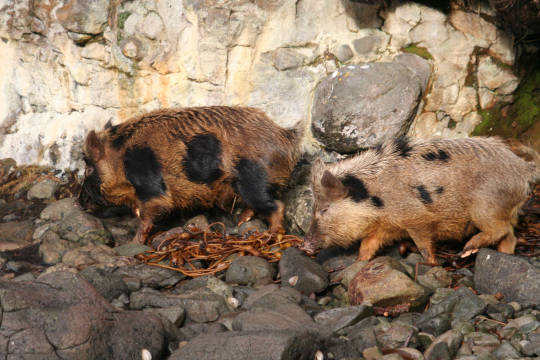
Auckland Island pigs scour the coastline for food. Due to their smaller stature compared to other breeds, the pigs are better candidates for xenotransplantation.
How New Zealand’s Pesky Pigs Turned Into a Cash Cow
The animals evolved into ultra-resilient, disease-free predators while isolated on Auckland Island.
Visual: New Zealand Department of Conservation
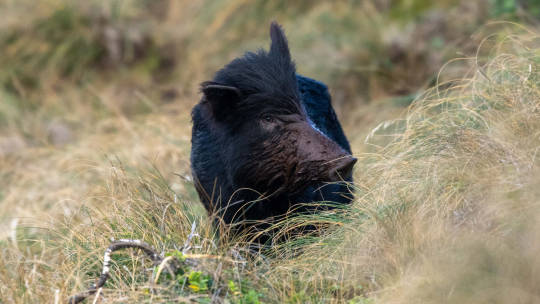
For now, the Auckland Island pigs continue to run free, but the clock is ticking: New Zealand’s Department of Conservation has been preparing for eradication.
#new zealand department of conservation#photographer#auckland island#wild pigs#pigs#animal#mammal#wildlife#new zealand#nature
26 notes
·
View notes
Text
EEEEEEEE EEEEEEEEE EEEEEEE
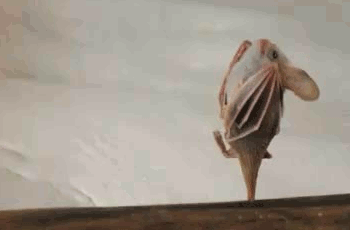
That's right! It's International Bat Appreciation Day! We share our planet with over 1400 species of bat, making the second most abundant mammal order, and they perform a wide variety of ecological roles, from dispersing seeds to pollinating flowers to eating thousands of insects in a single night! Over 200 bat species are listed as Threatened by the International Union for the Conservation of Nature--that is over 14 percent of all bats!
YOU can help endangered bats today by donating to Pennsylvania Bat Rescue at this link. This PA-based organization rehabilitates sick or injured bats and helps educate people like you and me in how we can create more bat-friendly environments.
If you want to learn about particularly-cool bat species native to New Zealand, check out this Consider Nature article on the Pekapeka, the bat that walks:
For the rest of the day, Consider Nature will be bat-bombing Tumblr with some of our favorite bat species to share them with the world!
Alt text: a small brown bat stretching its wings with the kind of fabulous flourish that would impress Ryan Evans.
#animals#nature#science#biology#wildlife#conservation#environment#bats#international bat appreciation day#batbombing
4K notes
·
View notes
Text
youtube
Today’s Ocean Race Show is short and has a tour of 1993-94 winner New Zealand Endeavour and a biologist discussing orca encounters. Well worth it!
0 notes
Text
"Two wild kiwi chicks were born near Wellington, New Zealand, about a year after a reintroduction program began in the city, the Capital Kiwi Project announced last week. The fluffy, brown babies are the first to be born near the country’s capital in at least 150 years.
“This is very special for the team, which has been working hard for the last few years,” project founder Paul Ward tells the Agence France-Presse. The chicks are a “massive milestone for our goal of building a wild population of kiwi on Wellington’s back doorstep.”
These flightless, chicken-sized birds were once abundant across New Zealand, with the nation’s five species numbering an estimated 12 million individuals in total. But nonnative predators and habitat loss caused their populations to plummet. Today, approximately 68,000 kiwis remain....
Conservation and reintroduction programs, including the Capital Kiwi Project, have been working to restore a large-scale wild kiwi population for years. In 2022, the organization released 11 kiwis into the wild in Makara, a suburb about seven miles west of Wellington. Between February and May of 2023, another 52 birds were released, and 200 more are slated to be released over the next five years, reports Eva Corlett for the Guardian.
Along with reintroduction efforts, the project aimed to reduce threats from European stoats, also known as ermines. The mammals were brought to New Zealand in the 19th century in an attempt to eradicate another introduced creature: rabbits. But these weasel-like stoats are voracious predators and kill many of New Zealand’s native species, including kiwi chicks. Only about 5 percent of kiwi chicks survive to reach breeding age in areas where predators are not controlled, largely thanks to stoats. In areas under management, however, 50 to 60 percent survive. Knowing this, conservationists worked with 100 landowners across the bird’s 60,000-acre habitat to install 4,600 stoat traps.
Of the 63 adult kiwis now roaming the hilly farmlands of Makara, only about a quarter are being monitored—meaning more chicks will likely hatch in the near future. Conservationists will continue monitoring the two new chicks, though Ward tells the Guardian they still have a long way to go before they’re fully grown...
Over the years, the long-beaked birds have become a national symbol of New Zealand, with people who hail from the country often referred to as kiwis. The animals also hold special importance to the Māori people of New Zealand, who have cultural, spiritual and historic associations with the birds. Even the New Zealand dollar is sometimes referred to as the kiwi, and the bird is featured on the country’s dollar coin."
-via Smithsonian Magazine, December 6, 2023
#aotearoa#new zealand#kiwi#kiwi bird#endangered species#birds#ornithology#conservation#invasive species#good news#hope
3K notes
·
View notes
Text
Sometimes, Chris Hayes' podcast goes off on these weird tangents, and the most recent episode is one of them, quite explicitly. It's about the history of Polynesia, which is always a fascinating subject--the Polynesian expansion, and really the whole history of the Austronesian-speaking peoples, seems like one of those feats with rare equal in human history. It's one thing to roam over the vast steppes of Asia--it's quite another to take a canoe, stick some outriggers on it so it doesn't tip over, and start faring the open ocean.
One point his guest makes that I found interesting is that for the most part the atolls and little islands of the Pacific are a very harsh environment. Big volcanic archipelagoes like Hawaii and Aotearoa/New Zealand are rare. Atolls and other reef islands especially are functionally big limestone slabs, often without any source of fresh water, with no large mammals, and with few native plants you can eat. The weather is nice, sure (when there isn't a typhoon--and I can't help but think a typhoon on a little island must be terrifying indeed), but these are not inherently resource-rich places. That the Polynesian (and Micronesian and Melanesian!) peoples not only could travel those distances, but make permanent habitation on the islands they came across, is kind of crazy! You have to be really prepared, with a package of supplies and technologies that set you up for success. Long-distance trade is possible, but you're not gonna be running any kind of substantial import economy across hundreds or thousands of miles of ocean via catamarans.
The comparison that springs to mind to me isn't a historical one like the European age of exploration, which was overwhelmingly to places already peopled and productive, but to science fiction scenarios of space exploration. You'd have to have a little bit of the wild-eyed zealot to be the sort of person who ignores the cries of "there is no possible useful return on this investment" to settle most of these places. But they did! And they thrived for centuries!
2K notes
·
View notes
Text

Here the result of the St. Bathans fauna stream! This one took us into the early Miocene of New Zealand, the Moa's ark, as some call it. After many formation streams with very few birds this one has probably way too many!

The St. Bathans fauna formed shortly after NZ reemerged after being nearly gone during the Oligocene. It preserves a rich, subtropical wetland community dominated by anseriformes. Boy do we have many ducks here!


Besides that the largest known parrots, flying kiwis, basal moas and surprising elements like crocodiles and turtles roamed here. Not to mention the mysterious St. Bathans mammal! As you can see in these size charts by Discord member Dynamoterror and @arminreindl, there is still much to draw!
#paleoart#sciart#paleostream#palaeoblr#formation pieces#miocene#new zealand#moas#squakzilla#heracles#flying kiwi#flying fruit#WE HAVE THE DUCKS
384 notes
·
View notes
Text
Round 3 - Mammalia - Chiroptera




(Sources - 1, 2, 3, 4)
Our next order of mammals is Chiroptera, commonly called “bats.” Chiroptera is the second largest order of mammals after Rodentia. Bats comprise about 20% of all classified mammal species worldwide, with over 1,400 species. They are divided into the families Pteropodidae (“megabats”), Rhinopomatidae (“mouse-tailed bats”), Craseonycteridae (“Kitti's Hog-nosed Bat”), Megadermatidae (“false vampire bats”), Rhinonycteridae (“trident bats”), Hipposideridae (“Old World leaf-nosed bats”), Rhinolophidae (“horseshoe bats”), Nycteridae (“slit-faced bats”), Emballonuridae (“sac-winged bats” and “sheath-tailed bats”), Myzopodidae (“sucker-footed bats”), Mystacinidae (“New Zealand short-tailed bats”), Thyropteridae (“disk-winged bats”), Furipteridae (“Smoky Bat” and “Thumbless Bat”), Noctilionidae (“bulldog bats”), Mormoopidae (“ghost-faced bats”, “mustached bats”, and “naked-backed bats”), Phyllostomidae (“New World leaf-nosed bats”), Natalidae (“funnel-eared bats”), Molossidae (“free-tailed bats”), Miniopteridae (“long-fingered” and “bent-winged bats”), Cistugidae (“wing-gland bats”), and Vespertilionidae (“vesper bats”).
Bats are the only mammals capable of true and sustained flight, with their forelimbs adapted as wings. Their wings are a patagium of skin stretched between 4 fingers, with their thumbs pointing forward and supporting the leading edge of the wing. The wings of bats are much thinner and consist of more bones than the wings of birds, allowing bats to maneuver more accurately and fly with more lift and less drag. The surface of the wings is equipped with touch-sensitive receptors on small bumps called Merkel cells, also found on human fingertips. In bats, each of these bumps has a tiny hair in the center, making it even more sensitive and allowing the bat to detect and adapt to changing airflow. While bats are highly agile in the air, they can only crawl or drag themselves awkwardly across the ground, and most of their time not in the air is spent roosting upside down. However, a few species, such as the New Zealand Lesser Short-tailed Bat (Mystacina tuberculata) and the Common Vampire Bat (Desmodus rotundus) are able to walk or even run on all fours. Most bats are insectivores, and most of the rest are frugivores (fruit-eaters) or nectarivores (nectar-eaters). A few feed on vertebrates, such as the specialized blood-drinking vampire bats (subfamily Desmodontinae), the bird-hunting Greater Noctule Bat (Nyctalus lasiopterus), the fish-catching Greater Bulldog Bat (Noctilio leporinus), the frog-eating Fringe-lipped Bat (Trachops cirrhosus), and the Spectral Bat (Vampyrum spectrum) and Ghost Bat (Macroderma gigas) which sometimes feed on other bats. Carnivorous bats make use of echolocation for navigation and finding prey, while herbivorous bats use their more well-developed eyesight. Apart from the Arctic, the Antarctic and a few isolated oceanic islands, bats exist in almost every habitat on Earth.
Some bats lead solitary lives, while others live in colonies of millions. In some, the females live in groups while the males are solitary, or males and females will live in separate groups. Most species are polygynous, where males mate with multiple females. Some species are promiscuous, where both sexes mate with multiple partners. A few species form monogamous pairs. Female bats use a variety of strategies to control the timing of pregnancy and the birth of young, to make delivery coincide with maximum food ability and other ecological conditions. In most bat species, females carry and give birth to a single pup per litter. The young emerges rear-first, possibly to prevent the wings from getting tangled, and the female cradles it in her wing and tail membranes. In social species, females give birth and raise their young in maternity colonies and may assist each other in birthing. A few species also assist in suckling other mothers’ young. Most of the care for a bat pup comes from the mother, but in monogamous species, the father will also play a role in childcare.
The fragile skeletons of bats do not fossilize well, but Chiroptera is assumed to have arisen in the Eocene. The oldest known bat fossils include Archaeonycteris praecursor and Altaynycteris aurora (55–56 million years ago), both known only from isolated teeth. The oldest complete bat skeleton is Icaronycteris gunnelli (52 million years ago).

Propaganda under the cut:
The eyes of most carnivorous bat species are small and poorly developed, leading to poor visual acuity, but no species is truly blind. Microbats may use their vision for orientation and while travelling between their roosting grounds and feeding grounds, as echolocation is effective only over short distances. Some species can even detect ultraviolet (UV) light.
The smallest mammal in the world is the Kitti's Hog-nosed Bat (Craseonycteris thonglongyai), also known as the Bumblebee Bat (though the the Etruscan Shrew [Suncus etruscus] is smaller by body mass). An adult Kitti's Hog-nosed Bat is about 29 to 33 mm (1.1 to 1.3 in) in length and weighs around 2 g (0.071 oz).
On the other wing, the largest bat in the world is the Giant Golden-crowned Flying Fox (Acerodon jubatus) which can reach a weight of 1.6 kg (3.5 lb) and has a wingspan of 1.7 m (5 ft 7 in).
Bat dung is mined as guano from caves and used as a highly effective fertilizer due to the high content of nitrogen, phosphate, and potassium, all key nutrients essential for plant growth. Bat guano also contains fine particles of insect exoskeleton, which are largely composed of chitin. Chitin from insect exoskeletons is an essential compound needed by beneficial soil fungi, as chitin is a major component of fungal cell wall membranes. This fungi then improves soil fertility. However, unsustainable harvesting of bat guano may cause bats to abandon their roost. Many cave ecosystems are wholly dependent on bats to provide nutrients via their guano which supports bacteria, fungi, invertebrates, and vertebrates in the cave. The loss of bats from a cave can result in the extinction of species that rely on their guano.
The extinct bats Palaeochiropteryx tupaiodon and Hassianycteris kumari, both of which lived 48 million years ago, are the first fossil mammals whose colorations have been discovered. Both were reddish-brown.
The fastest flying bat, the Mexican Free-tailed Bat (Tadarida brasiliensis), can achieve a ground speed of 160 km/h (100 mph)!
Mexican Free-tailed Bats are one of the few species to "sing" like birds. Males sing to attract females.
Greater Bulldog Bats (Noctilio leporinus) “honk” to warn each other when they may be about to collide.
Carnivorous bats make use of magnetoreception, in that they have a high sensitivity to the Earth's magnetic field, like birds. These bats use a polarity-based compass, meaning that they differentiate North from South, unlike birds, which use the strength of the magnetic field to differentiate latitudes.
Scientists reported in January 2025 that they had discovered how some bats travel hundreds of miles in the spring to give birth in warmer temperatures: they surf storm fronts.
The Spotted Bat (Euderma maculatum) can travel as much as 38.5 km (24 mi) in one night in search of food.
Many species of plants depend on bats for seed dispersal. The Jamaican Fruit Bat (Artibeus jamaicensis) has been recorded carrying fruits weighing 3–14 g or even as much as 50 g.
Nectar-eating bats have acquired specialised adaptations. These bats possess long muzzles and long, extensible tongues covered in fine bristles that aid them in feeding on particular flowers and plants. These long, narrow tongues can reach deep into the long cup shape of some flowers. When the tongue retracts, it coils up inside the rib cage. The Tube-lipped Nectar Bat (Anoura fistulata) has the longest tongue of any mammal relative to its body size.
Around 500 species of flowering plant rely on bat pollination. Because of this, some of these flowers have adapted to only open their flowers at night.
Due to the specialized metabolism of Vampire Bats (subfamily Desmodontinae) they are highly susceptible to starvation if they fail to feed within 70 hours. To combat this, vampire bats engage in reciprocal altruism, and will feed each other by regurgitating blood. If a bat cannot find food two nights in a row, due to injury, illness, or simple unluckiness, one of its colony mates may feed it. Vampire bats who are more “popular” in the colony may be fed more often.
White-nose syndrome (WNS) is a fungal disease in North American bats which has resulted in the dramatic decrease of the bat population in the United States and Canada, killing millions and causing a 90% decline in some areas. The condition is named for a distinctive fungal growth of Pseudogymnoascus destructans around the muzzles and on the wings of hibernating bats. It is likely the fungus was brought to North America from Europe by cavers who didn’t wash their equipment. Bats in Europe seem to be resistant to the fungus. The Forest Service estimated in 2008 that the die-off from white-nose syndrome means that at least 2.4 million pounds (1.1 million kg or 1,100 tons) of insects will go uneaten, possibly leading to crop damage or having other economic impact.
It has been estimated that bats save the agricultural industry of the United States anywhere from $3.7 billion to $53 billion per year in pesticides and damage to crops. This also prevents the overuse of pesticides, which can pollute the surrounding environment, and may lead to resistance in future generations of insects.
Homosexual relations have been observed in the Bonin Flying Fox (Pteropus pselaphon) and the Indian Flying Fox (Pteropus medius).
The Christmas Island Pipistrelle (Pipistrellus murrayi) was declared extinct in 2009. This extinction was likely caused by introduced, invasive species such as Domestic Cats (Felis catus), Black Rats (Rattus rattus), Common Wolf Snakes (Lycodon capucinus), and Yellow Crazy Ants (Anoplolepis gracilipes). The bats could have also been poisoned by the insecticide Fipronil, used to control Yellow Crazy Ant Colonies.
In China, bats have been associated with happiness, joy, and good fortune. Five bats are used to symbolise the "Five Blessings": longevity, wealth, health, love of virtue, and peaceful death.
A new threat to bats has arisen in the form of bat taxidermy. Bat taxidermy, where bats are either mounted in glass, encased in resin, articulated as a skeleton, or simply stuffed, is growing in popularity as “quirky” decor. However, many sellers will claim to be ethical when they are not, and are actually catching and killing bats to meet the rising demand of this new market. In some cases, entire caves will be gassed so that the bat carcasses can be harvested by the thousands. Many of the bat species used for oddity decor are declining or even endangered. The transport of bat carcasses overseas has also been linked to the spread of disease.
#I’m sorry it’s another long one this just kinda has to happen when the order is very diverse ;_;#it’s harder to summarize#animal polls#round 3#mammalia
118 notes
·
View notes
Note
Southern right whale dolphins
Oh a very cool one, hadn't seen them before! Thank you!


Photos from Gerard Bodineau & Toby Dickson, respectively.
#south america#australia#new zealand#south africa#southern ocean#southern right whale#southern right whale dolphin#dolphin#artiodactyla#cetacea#cetacean#delphinidae#marine mammals#marine biology#sea life#marine life#marine animals#animal polls#poll blog#my polls#animals#polls#tumblr polls#mammalia#mammals#mammal
64 notes
·
View notes
Text
Good morning yall! Hope you're ready for a new fish today cuz we got an all timer here today!
Today's fish is none other than my personal favorite fish, the Brook Trout (salvelinus fontinalis)! These beauties are native to Eastern North America, in both Canada and the United States, ranging from Lake Superior, to the coastal waterways from the Hudson Bay to Long Island, though they have spread far beyond their native ranges, mostly via aquacultural practices and artificial propagation, making them invasive species in many regions of North America and the world at large!

Two ecological forms of Brook Trout have been recognized by the US Forest Service, the longer-living potamodromous (fish whose migration occurs fully within fresh water) population, known as coasters , and the anadromous (fish whose migration occurs from fresh water to salt water) population, known as salters. Adult coasters typically reach lengths over 2 feet in length and weigh up to 15lbs, compared to adult salters, which average between 6 to 15 inches and about 5lbs. They're characterized by their vibrant coloration, with olive green bodies and spectacular yellow and blue rimmed red spots, white and black trimming along their orange fins, and dense, irregular lines along the top of their bodies. Often, the bellies of male Brook Trout becomes bright red or orange when spawning.
During the spawning season, female Brook Trout will construct a depression in the stream bed, referred to as a "redd", where groundwater percolates upward through the gravel. Male Brook Trout will approach the female, fertilizing the eggs. The eggs are only slightly denser than water, and can easily be swept away by the current. To avoid this, the female will bury the eggs in a small gravel mound, from which they hatch 4 to 6 weeks later. During this incubation period, the eggs receive oxygen from the streamwater that passes through the gravel beds and into their gelatinous shells. Once they hatch into small fry fish that retain their yolk sack for nutrients, which compensates for the lack of nutrients provided by the parents during the early stages of development. Following the consumption of the yolk, the fry Brook Trout will shelter from predatory species in rocky crevices and inlets, growing from fry to fingerlings, until reaching full maturation at the ripe old age of 6 months.

Despite their native range spanning across low-elevation lakes and watersheds, Brook Trout are increasingly confined to higher elevations in the Appalachian Mountains, especially in southern regions of Appalachia. Over seas, however, Brook Trout have thrived in introduced populations in much of Europe, Argentina, and New Zealand since as early as the 1850's! Their typical habitats include large and small lakes, rivers, creeks, and spring ponds in cold temperate climates. They thrive in clear spring water with moderate flow rates and healthy vegetation populations and other resources which provide natural hiding places. Although they are more resilient and adaptable to varying environmental changes, such as pH levels and temperatures, Brook Trout struggle in temperatures warmer than 72 degrees Fahrenheit. Their diets include aquatic insects at all stages of life, adult terrestrial insects such as grasshoppers and crickets, crustaceans and frogs, molluscs, invertebrates, smaller fish, and even small aquatic mammals such as voles, and even other young Brook Trout! This highly indiscriminate diet and environmental resiliency allows for their success across the globe.
Given all of this, Brook Trout are classified as a Secure by NatureServe's conservation metrics, but that label may be misleading; these incredible fish face severe and repeated extirpation (localized extinction) in many of their native habitats due to habitat destruction, pollution, damming, and invasive species. Meanwhile, Brook Trout present the danger of extirpation to other fish in their nonnative habitats, indicating that efforts must be taken to curb these populations. In short, there are more than enough Brook Trout, but they simply are not where they are meant to be.
A true fish out of (the specifically correct body of) water, the Brook Trout scores within the top percentile of all fishies on our highly advanced fish ranking scale.

94 notes
·
View notes
Text
Round One: Connoisseur Critters
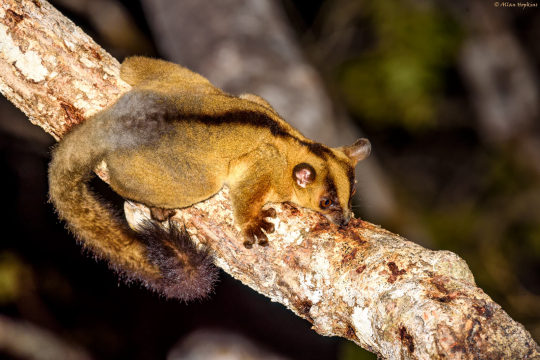
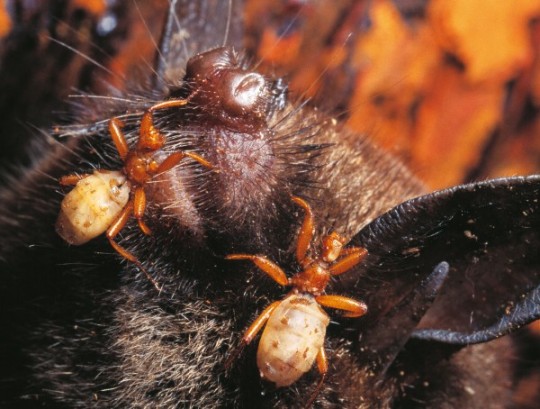
Fork-marked Lemur vs New Zealand Batfly
Arena: Tropical forest
Remember, it's not a popularity contest- it's a fight to the death!
29 notes
·
View notes
Text
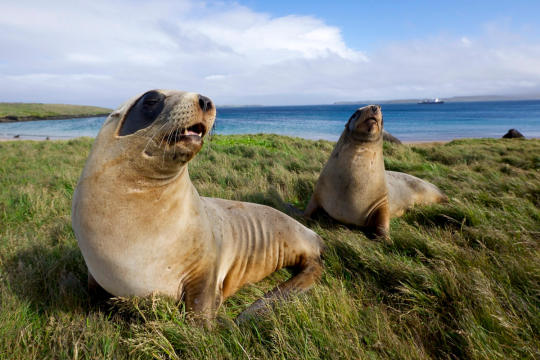
Female sea lions on Enderby Island. The opportunistic pigs living nearby will scavenge “dead whales and seals or even krill and squid,” said Horn.
Visual: Bill Morris for Undark
16 notes
·
View notes
Text

Kiwi (Apteryx) - a genus of flightless birds endemic to New Zealand. They're the smallest of the ratites, a group that includes ostriches, emus, cassowaries, the extinct moas and elephant birds - kiwi's closest relatives, with both lineages diverging 54 million years ago. There are five species of kiwi found in habitats ranging from subalpine scrub to podocarp forests throughout New Zealand. While none overlap today, they were widespread before the introduction of mammals such as stoats, the kiwi's main predator, and several species coexisted.

Despite differences in size, colour and habitat, all kiwi species share traits such as sexual dimorphism; females are larger than males, reliance on hearing and smell rather than sight, an omnivorous diet, and a nocturnal lifestyle; possibly a result of mammalian predators.


Kiwis were thought to be closely related to the extinct moa due to shared traits. However, DNA studies show they're closer to Madagascar's elephant birds, rather than to the moa, with which they shared New Zealand. The kiwi's massive eggs were once thought to be a shared trait with its relatives, the elephant birds; which laid the largest eggs ever recorded. However, it's now thought to be an adaptation for precocity, allowing the chicks to hatch mobile with yolk to sustain them. Fossils of the extinct genus of kiwi - Proapteryx, suggest that their ancestors were capable of flight and lost this ability after reaching New Zealand. This also suggests that kiwis arrived in New Zealand independently and much later than the Moas, which were already there.

83 notes
·
View notes